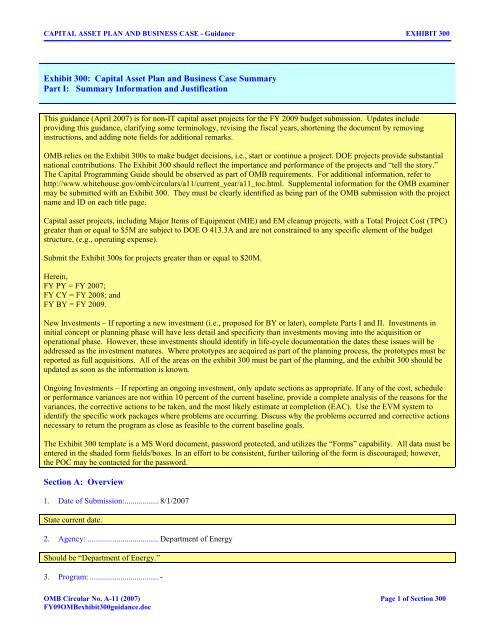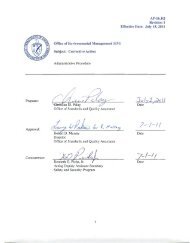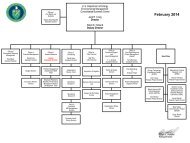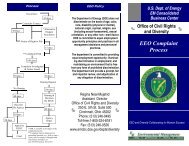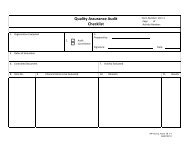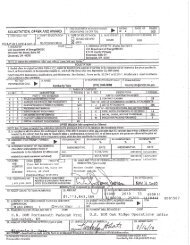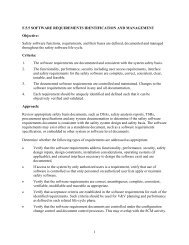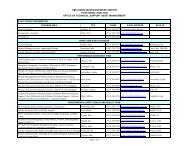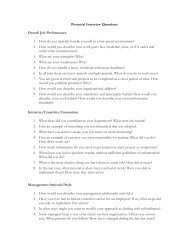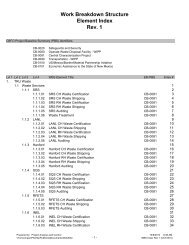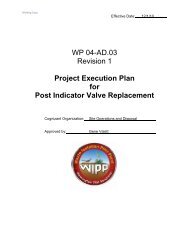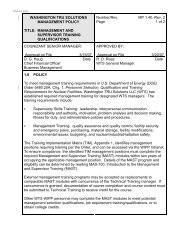Exhibit 300: Capital Asset Plan and Business Case Summary Part I ...
Exhibit 300: Capital Asset Plan and Business Case Summary Part I ...
Exhibit 300: Capital Asset Plan and Business Case Summary Part I ...
Create successful ePaper yourself
Turn your PDF publications into a flip-book with our unique Google optimized e-Paper software.
CAPITAL ASSET PLAN AND BUSINESS CASE - Guidance EXHIBIT <strong>300</strong><strong>Exhibit</strong> <strong>300</strong>: <strong>Capital</strong> <strong>Asset</strong> <strong>Plan</strong> <strong>and</strong> <strong>Business</strong> <strong>Case</strong> <strong>Summary</strong><strong>Part</strong> I: <strong>Summary</strong> Information <strong>and</strong> JustificationThis guidance (April 2007) is for non-IT capital asset projects for the FY 2009 budget submission. Updates includeproviding this guidance, clarifying some terminology, revising the fiscal years, shortening the document by removinginstructions, <strong>and</strong> adding note fields for additional remarks.OMB relies on the <strong>Exhibit</strong> <strong>300</strong>s to make budget decisions, i.e., start or continue a project. DOE projects provide substantialnational contributions. The <strong>Exhibit</strong> <strong>300</strong> should reflect the importance <strong>and</strong> performance of the projects <strong>and</strong> “tell the story.”The <strong>Capital</strong> Programming Guide should be observed as part of OMB requirements. For additional information, refer tohttp://www.whitehouse.gov/omb/circulars/a11/current_year/a11_toc.html. Supplemental information for the OMB examinermay be submitted with an <strong>Exhibit</strong> <strong>300</strong>. They must be clearly identified as being part of the OMB submission with the projectname <strong>and</strong> ID on each title page.<strong>Capital</strong> asset projects, including Major Items of Equipment (MIE) <strong>and</strong> EM cleanup projects, with a Total Project Cost (TPC)greater than or equal to $5M are subject to DOE O 413.3A <strong>and</strong> are not constrained to any specific element of the budgetstructure, (e.g., operating expense).Submit the <strong>Exhibit</strong> <strong>300</strong>s for projects greater than or equal to $20M.Herein,FY PY = FY 2007;FY CY = FY 2008; <strong>and</strong>FY BY = FY 2009.New Investments – If reporting a new investment (i.e., proposed for BY or later), complete <strong>Part</strong>s I <strong>and</strong> II. Investments ininitial concept or planning phase will have less detail <strong>and</strong> specificity than investments moving into the acquisition oroperational phase. However, these investments should identify in life-cycle documentation the dates these issues will beaddressed as the investment matures. Where prototypes are acquired as part of the planning process, the prototypes must bereported as full acquisitions. All of the areas on the exhibit <strong>300</strong> must be part of the planning, <strong>and</strong> the exhibit <strong>300</strong> should beupdated as soon as the information is known.Ongoing Investments – If reporting an ongoing investment, only update sections as appropriate. If any of the cost, scheduleor performance variances are not within 10 percent of the current baseline, provide a complete analysis of the reasons for thevariances, the corrective actions to be taken, <strong>and</strong> the most likely estimate at completion (EAC). Use the EVM system toidentify the specific work packages where problems are occurring. Discuss why the problems occurred <strong>and</strong> corrective actionsnecessary to return the program as close as feasible to the current baseline goals.The <strong>Exhibit</strong> <strong>300</strong> template is a MS Word document, password protected, <strong>and</strong> utilizes the “Forms” capability. All data must beentered in the shaded form fields/boxes. In an effort to be consistent, further tailoring of the form is discouraged; however,the POC may be contacted for the password.Section A: Overview1. Date of Submission:................. 8/1/2007State current date.2. Agency: ................................... Department of EnergyShould be “Department of Energy.”3. Program: .................................. -OMB Circular No. A-11 (2007) Page 1 of Section <strong>300</strong>FY09OMBexhibit<strong>300</strong>guidance.doc
CAPITAL ASSET PLAN AND BUSINESS CASE - Guidance EXHIBIT <strong>300</strong>State program name <strong>and</strong> subprogram (as applicable), e.g., Office of Science/Basic Energy Science.4. Project Name: .......................... -State project name <strong>and</strong> site (as applicable), e.g., SNM Component Requalification Facility at Pantex <strong>Plan</strong>t. Project name <strong>and</strong>site should be same as budget documentation, associated PDS (if PDS is required), <strong>and</strong> PARS.5. Project ID: ............................ -Project ID should be same as budget documentation, associated PDS (if PDS is required), <strong>and</strong> PARS.6. What kind of investment will this be in FY BY?<strong>Plan</strong>ningFull AcquisitionOperations <strong>and</strong> MaintenanceMixed Life CycleE-Gov/LoB OversightState project current status. Should be either “planning” <strong>and</strong>/or “full acquisition”; otherwise, contact the designated point ofcontact in the budget call.terminology:<strong>Plan</strong>ning means preparing, developing or acquiring the information you will use to: design the investment; assess thebenefits, risks, <strong>and</strong> risk-adjusted life-cycle costs of alternative solutions; <strong>and</strong> establish realistic cost, schedule, <strong>and</strong>performance goals, for the selected alternative, before either proceeding to full acquisition of the capital project (investment)or useful segment or terminating the investment. <strong>Plan</strong>ning must progress to the point where you are ready to commit toachieving specific goals for the completion of the acquisition before preceding to the acquisition phase. Informationgathering activities may include market research of available solutions, architectural drawings, geological studies,engineering <strong>and</strong> design studies, <strong>and</strong> prototypes. <strong>Plan</strong>ning is a useful segment of a capital project (investment). Depending onthe nature of the investment, one or more planning segments may be necessary.Full Acquisition includes procurement <strong>and</strong> implementation of a project, which occurs after planning activities are mature <strong>and</strong>baseline <strong>and</strong> cost <strong>and</strong> performance goals are established.Operations <strong>and</strong> Maintenance occurs when investment is operational <strong>and</strong> only needs to perform maintenance to remain stable.Mixed life-cycle investment means an investment having both development/modernization/enhancement (DME) <strong>and</strong> steadystate components. For example, a mixed life-cycle investment could include a prototype or module of a system that isoperational with the remainder of the system in DME stages; or, a service contract for steady state on the current system witha DME requirement for system upgrade or replacement.E-Gov/LoB Oversight is used by the Managing <strong>Part</strong>ner/Agency for multi-agency initiatives.7. What was the first budget year this investment was submitted to OMB?.................................................. FYState fiscal year investment was initially submitted to OMB. In general, this may be when CD-0 was approved.8. Provide a brief summary <strong>and</strong> justification:The most recent DOE O 413.3A approved Critical Decision is CD- that was approved on with a TotalProject Cost (TPC) or preliminary cost estimate range of .Initial statement should provide status of the project, e.g., information concerning the most recent CD approval.OMB Circular No. A-11 (2007) Page 2 of Section <strong>300</strong>FY09OMBexhibit<strong>300</strong>guidance.doc
CAPITAL ASSET PLAN AND BUSINESS CASE - Guidance EXHIBIT <strong>300</strong>Statement should address how this project addresses an identified performance gap. It should answer “What is it that DOEcannot do now, that they will be able to do with this investment?” or, if project is on-going, “What could DOE no longer do ifthis investment were cancelled?”9. Did the Acquisition Executive approve this request? ................................................................................ Yes Noa. If “yes,” what was approval date of this approval? .....................................................................The AE should have reviewed this request. If a major system project, the program PSO or PMSO should have reviewed thisrequest. State the latest CD approval date that was approved by the AE. If project has CD-2 approval <strong>and</strong> has a BCP, statethe latest BCP approval date that was approved by the AE.10. Did the Federal Project Director review this <strong>Exhibit</strong>?............................................................................... Yes NoThe FPD should have reviewed this request.11. Contact information of Federal Project Director?Name: ...................................... -Phone Number:........................ -E-mail: ..................................... -PMCDP Certification Level: ... -FPD information should be same as PARS <strong>and</strong> OECM’s Deputy Secretary report.12. Has the agency developed <strong>and</strong>/or promoted cost effective, energy-efficient <strong>and</strong> environmentally sustainable techniquesor practices for this project? ...................................................................................................................... Yes Noa. Will this investment include electronic assets (including computers)? ....................................... Yes Nob. Is this investment for new construction or major retrofit of a Federal building or facility?........ Yes Noi. If “yes,” is an ESPC or UESC being used to help fund this investment?...................... Yes Noii. If “yes,” will this investment meet sustainable design principles?................................ Yes Noiii. If “yes,” is it designed to be 30% more energy efficient than relevant code?............... Yes NoThe Energy Policy Act of 2005, Section 109, which requires that sustainable design principles are applied to the siting,design <strong>and</strong> construction of all new <strong>and</strong> replacement buildings <strong>and</strong> that new federal buildings be designed to achieve energyconsumption levels that are at least 30 percent below the levels established in the 2004 International Energy ConservationCode for residential buildings or the ASHRAE St<strong>and</strong>ard 90.1-2004 for non-residential buildings, if life-cycle cost effective.Consistent with DOE O 413.3A requiring compliance to sustainable environmental stewardship throughout the CD process,observe Executive Order 13423, Strengthening Federal Environmental, Energy, <strong>and</strong> Transportation Management <strong>and</strong> theimplementation instructions that was developed in consultation with OMB. For additional information, refer tohttp://www1.eere.energy.gov/femp/about/eo_fedmgmt.html.Apply life-cycle cost-effective, sustainable principles, defined per the Guiding Principles for Federal Leadership in HighPerformance <strong>and</strong> Sustainable Buildings, to the siting, design, <strong>and</strong> construction of DOE buildings. Incorporate sustainableprinciples into project feasibility studies <strong>and</strong>/or at the earliest stages of project planning. These requirements apply toconstruction of new DOE buildings; new, renegotiation, or extension of leases for Federal occupancy; <strong>and</strong> major renovationprojects. A sustainable siting, design, or construction measure is considered life-cycle cost effective in the methodologydefined in 10 CFR <strong>Part</strong> 436, subpart A, if it meets the requirements for life cycle cost effectiveness on an individual basis,within a bundled set of measures, or within the whole building design. DOE sites are encouraged to meet the sustainablebuilding requirements of Executive Order 13423 through the use of independent third-party certification, such as the U.S.Green Building Council's LEED® rating system <strong>and</strong> the use of independent commissioning authorities. The DOE includingthe NNSA should strive to achieve the Gold LEED certification on all construction projects as a minimum st<strong>and</strong>ard. Due tothe flexible nature of these systems however, certification to these rating systems does not necessarily translate into meetingall the requirements of the Guiding Principles. To do so, agencies are encouraged to require certain "credits" within eachrating system that parallel the requirements in the Guiding Principles.OMB Circular No. A-11 (2007) Page 3 of Section <strong>300</strong>FY09OMBexhibit<strong>300</strong>guidance.doc
CAPITAL ASSET PLAN AND BUSINESS CASE - Guidance EXHIBIT <strong>300</strong>terminology:Energy savings performance contract (ESPC) means a contract providing for the performance of services for the design,acquisition, financing, installation, testing, operation, <strong>and</strong>, where appropriate, maintenance <strong>and</strong> repair of an identified energyor water conservation measure or series of measures at one or more locations. Future energy savings are guaranteed by thecontractor <strong>and</strong> the contractor is paid by the government over time from the savings resulting from reduced energy billpayments.Utility Energy Efficiency Service Contract (UESC) means a local utility providing up-front project financing of energyefficiency <strong>and</strong> related measures, <strong>and</strong> then having Federal agencies pay for the services over time, either on their utility bill, orthrough a separate dem<strong>and</strong>-side management agreement. See FAR <strong>Part</strong> 41 for more information.13. Does this investment directly support one of the PMA initiatives? If “yes,” check all that apply:Human <strong>Capital</strong>Budget Performance IntegrationFinancial PerformanceExp<strong>and</strong>ed E-GovernmentCompetitive SourcingFaith Based <strong>and</strong> CommunityReal Property <strong>Asset</strong> ManagementEliminating Improper PaymentsPrivatization of Military HousingResearch & Development Investment CriteriaHousing & Urban Dev. Management & PerformanceBroadening Health Insurance Coverage through StateInitiatives“Right Sized” Overseas PresenceCoordination of VA & DoD Programs <strong>and</strong> SystemsThe President’s Management Agenda (PMA) contains five government-wide <strong>and</strong> nine agency-specific goals to improvefederal management <strong>and</strong> deliver results that matter to the American people. For additional information, refer tohttp://www.energy.gov/pma.htm.In coordination with program’s management, check only the applicable PMA initiatives.14. Does this investment support a program assessed using the PART?......................................................... Yes Noa. If “yes,” does this investment address a weakness found during a PART review?..................... Yes Nob. If “yes,” what is the name of the PARTed program? ......... -c. If “yes,” what rating did the PART receive? ...................... -The Program Assessment Rating Tool (PART) assesses each program’s purpose, links to the Strategic <strong>Plan</strong>, managementdecision-making, <strong>and</strong> performance results. For additional information, refer tohttp://www.energy.gov/about/performance.htm.15. Is this investment for information technology? ........................................................................................ Yes NoShould be “No.”Section B: <strong>Summary</strong> of Spending1. Provide the total estimated life-cycle cost for this investment by completing the following table.<strong>Plan</strong>ning:Acquisition:SubtotalTable 1: SUMMARY OF SPENDING FOR PROJECT PHASES(REPORTED IN MILLIONS)(Estimates for BY+1 <strong>and</strong> beyond are planning purposes only <strong>and</strong> do not represent budget decisions)FY PY-1<strong>and</strong>earlierFY PY FY CY FY BYFYBY+1FYBY+2FYBY+3FYBY+4<strong>and</strong>beyondTotalOMB Circular No. A-11 (2007) Page 4 of Section <strong>300</strong>FY09OMBexhibit<strong>300</strong>guidance.doc
CAPITAL ASSET PLAN AND BUSINESS CASE - Guidance EXHIBIT <strong>300</strong>Contracts/Task Orders TableContract orTask OrderNumberType ofContract/TaskOrderHas the contract been awarded? (Y/N)Is so, what is the date of the award?If not, what is the planned award date?Start date of Contract/Task OrderEnd date of Contract/Task OrderTotal Value of Contract/Task Order ($M)Is this an Interagency Acquisition? (Y/N)Is it performance based? (Y/N)Competitively awarded? (Y/N)What, if any, alternative financing option isbeing used? (ESPC, UESC, EUL, N/A)Is EVM in the contract? (Y/N)Does the contract include the requiredsecurity & privacy clauses? (Y/N)Name of COCO Contact information (phone/email)CO Certification Level ( Level 1, 2, 3, N/A)If N/A, has the agency determined the COassigned has the competencies <strong>and</strong> skillsnecessary to support this acquisition?(Y/N)- - -notes:List all major prime contracts (e.g., M&O) or task orders for the specific project. If M&O or prime(s) manage the project,list the sub-contract <strong>and</strong> the project specific contract(s) or task order(s).terminology:Total Value of Contract/Task Order means the current total value of the Contract or Task Order to acquire <strong>and</strong> operate thecapital asset. For contracts/task orders shared by multiple capital assets, please provide only the current total value associatedto the identified capital asset. Total Value should include all option years for each contract. Contracts <strong>and</strong>/or task orderscompleted do not need to be includedInteragency acquisition means the use of the Federal Supply Schedules, a multi-agency contract, or a government-wideacquisition contract.Performance-based acquisition management means a documented, systematic process for program management, whichincludes integration of program scope, schedule <strong>and</strong> cost objectives, establishment of a baseline plan for accomplishment ofprogram objectives, <strong>and</strong> use of earned value techniques for performance measurement during execution of the program.OMB Circular No. A-11 (2007) Page 6 of Section <strong>300</strong>FY09OMBexhibit<strong>300</strong>guidance.doc
CAPITAL ASSET PLAN AND BUSINESS CASE - Guidance EXHIBIT <strong>300</strong>Enhanced Use Leasing (EUL): Departments with specific statutory authority can require rent in the form of a reduction in thecost or free use of facilities or services for programs, monetary payments, or other in-kind consideration which enhancesmission activity. This authority allows an agency to out-lease property <strong>and</strong> receive payment in cash or in kind (goods orservices that result in direct cost savings to the government) from the lessee in exchange for the out-lease.Contracting officer certification means the highest current level of certification in contracting obtained by the contractingofficer (CO) assigned to the acquisition. For civilian agencies, indicate the CO’s highest level of Federal AcquisitionCertification in Contracting (FAC-C), in accordance with OMB memor<strong>and</strong>um, The Federal Acquisition Certification inContracting Program, dated January 20, 2006. Available levels are 1, 2, or 3. The FAC-C is a new program that civilianagencies are in the process of implementing. To address the transition period, if the CO has not obtained a FAC-C, theagency must determine that the CO assigned to the effort has the competencies <strong>and</strong> skills necessary to support the acquisition.2. If earned value is not required or will not be a contract requirement for any of the contracts or task orders above, explainwhy:-If EVMS certification has been certified by, reviewed by, or scheduled to be reviewed by OECM, state EVMS certificationstatus.3. Do the contracts ensure Section 508 compliance?....................................................................... N/A Yes Noa. Explain why:-Applicable to non-IT capital asset projects. For additional information, refer to http://www.section508.gov.In 1998, Congress amended the Rehabilitation Act to require Federal agencies to make their electronic <strong>and</strong> informationtechnology accessible to people with disabilities. Inaccessible technology interferes with an individual's ability to obtain <strong>and</strong>use information quickly <strong>and</strong> easily. Section 508 was enacted to eliminate barriers in information technology, to makeavailable new opportunities for people with disabilities, <strong>and</strong> to encourage development of technologies that will help achievethese goals. The law applies to all Federal agencies when they develop, procure, maintain, or use electronic <strong>and</strong> informationtechnology. Under Section 508 (29 U.S.C. ‘ 794d), agencies must give disabled employees <strong>and</strong> members of the public accessto information that is comparable to the access available to others.4. Is there an acquisition plan which has been approved in accordance with agency requirements? ............ Yes Noa. If “yes,” what is the date?............................................................................................................b. If “no,” will an acquisition plan be developed?........................................................................... Yes Noi. If “no,” briefly explain why:-Question refers to the Acquisition <strong>Plan</strong> not the Acquisition Strategy. The process of choosing the best capital asset startswith the development of a strategy to review the market <strong>and</strong> ends with the development of an acquisition plan that outlinesthe best approach to acquire the recommended asset. For additional information, refer to the <strong>Capital</strong> Programming Guide <strong>and</strong>the FAR.Section D: Performance InformationThe Federal Acquisition Streamlining Act of 1994, Title V (FASA V), which requires agencies to establish cost, schedule<strong>and</strong> measurable performance goals for all major acquisition programs, <strong>and</strong> achieve on average 90 percent of those goals.In order to successfully address this area of the exhibit <strong>300</strong>, performance goals must be provided for the agency <strong>and</strong> be linkedto the annual performance plan. The investment must discuss the agency’s mission <strong>and</strong> strategic goals, <strong>and</strong> performancemeasures must be provided. These goals need to map to the gap in the agency's strategic goals <strong>and</strong> objectives this investmentis designed to fill. They are the internal <strong>and</strong> external performance benefits this investment is expected to deliver to theagency (e.g., improve efficiency by 60 percent, increase citizen participation by <strong>300</strong> percent a year to achieve an overallOMB Circular No. A-11 (2007) Page 7 of Section <strong>300</strong>FY09OMBexhibit<strong>300</strong>guidance.doc
CAPITAL ASSET PLAN AND BUSINESS CASE - Guidance EXHIBIT <strong>300</strong>citizen participation rate of 75 percent by FY 2xxx, etc.). The goals must be clearly measurable investment outcomes, <strong>and</strong> ifapplicable, investment outputs. They do not include the completion date of the module, milestones, or investment, or generalgoals, such as, significant, better, improved that do not have a quantitative or qualitative measure.In order to successfully address this area of the exhibit <strong>300</strong>, performance goals must be provided for the agency <strong>and</strong> be linkedto the annual performance plan. Agencies must use Table 1 below for reporting performance goals <strong>and</strong> measures.FiscalYearStrategic Goal(s)SupportedPerformanceMeasurePerformance Information Table 1:Actual/Baseline(from Previous Year)<strong>Plan</strong>nedPerformance Metric(Target)Performance MetricResults(Actual)notes:<strong>Part</strong> II: <strong>Plan</strong>ning, Acquisition <strong>and</strong> Performance InformationSection A: Alternatives AnalysisIn selecting the best capital asset, you should identify <strong>and</strong> consider at least three viable alternatives, in addition to the currentbaseline, i.e., the status quo. For additional information, refer to OMB Circular A-94http://www.whitehouse.gov/omb/circulars/a094/a094.html.Consider a wide range of alternatives to bridge a performance gap, including noncapital alternatives, before choosing topurchase or construct a capital asset or facility. These options include contracting out, privatizing the activity, nonownershipoptions such as leasing, or engaging in joint venture projects with other organizations to minimize the amount invested <strong>and</strong>reduce the organization’s risk. If it is determined that a capital asset is needed to bridge a performance gap, consider the useof existing assets before choosing to purchase or construct new assets. (source: GAO-07-274, Federal <strong>Capital</strong>-ThreeEntitites’ Implementation of <strong>Capital</strong> <strong>Plan</strong>ning Principles Is Mixed, February 2007, p.14)1. Did you conduct an alternatives analysis for this project?......................................................................... Yes Noa. If “yes,” provide the date the analysis was completed? ..............................................................b. If “no,” what is the anticipated date this analysis will be completed? ........................................c. If no analysis is planned, please briefly explain why:-State “Yes” if project has an approved Acquisition Strategy; otherwise, state “No.”2. Alternatives Analysis Results: Use the results of your alternatives analysis to complete the following table:AlternativeAnalyzedBaselineStatus quoAlternatives Analysis ResultsDescription of AlternativeRisk AdjustedLifecycle CostsestimateRisk AdjustedLifecycleBenefitsestimateOMB Circular No. A-11 (2007) Page 8 of Section <strong>300</strong>FY09OMBexhibit<strong>300</strong>guidance.doc
CAPITAL ASSET PLAN AND BUSINESS CASE - Guidance EXHIBIT <strong>300</strong>AlternativeAnalyzedAlternatives Analysis ResultsDescription of AlternativeRisk AdjustedLifecycle CostsestimateRisk AdjustedLifecycleBenefitsestimateAlternative analysis results should be same as CD-1 documentation, e.g., approved Acquisition Strategy.terminology:Risk adjusted life-cycle costs means the overall estimated cost for a particular investment alternative over the time periodcorresponding to the life of the investment, including direct <strong>and</strong> indirect initial costs plus any periodic or continuing costs ofoperation <strong>and</strong> maintenance that has been adjusted to accommodate any risk identified in the risk management plans. If projectfunding is to be requested for specific phases, segments or modules of the project, each of these parts will be risk adjusted fortheir individual life-cycle.3. Which alternative was selected by the Acquisition Executive <strong>and</strong> why was it chosen?-Consider commenting on viability of noncapital alternatives <strong>and</strong> use of existing assets.4. What specific qualitative benefits will be realized?-State qualitative benefits from the investment.Section B: Risk ManagementRisk management is an essential element of every project. Consistent with DOE O 413.3A, project should have performed arisk assessment during the early planning <strong>and</strong> initial concept phase of this investment’s life-cycle, developed a risk-adjustedlife-cycle cost estimate <strong>and</strong> a plan to eliminate, mitigate or manage risk, <strong>and</strong> be actively managing risk throughout theinvestment’s life-cycle.1. Does the investment have a Risk Management <strong>Plan</strong>?................................................................................Yes Noa. If “yes,” what is the date of the plan?..........................................................................................b. Has the Risk Management <strong>Plan</strong> significantly changed since last submission to OMB? ............. Yes Noc. If “yes,” describe any significant changes:-If project has CD-1 approval, there should be a RMP. State the date of the latest approved plan. It is important to state anysignificant changes to the risk identification, analysis, planning, h<strong>and</strong>ling, or monitoring. It is also important to elaborate onthe higher level risks from current status leading to FY BY.2. If there currently is no plan, will a plan be developed? ............................................................................. Yes Noa. If “yes,” what is the planned completion date? ..........................................................................b. If “no,” what is the strategy for managing the risks?-Leave fields blank if answer to question 1 is “No.” In general, provide answers to question 2 if project does not have CD-1approval, <strong>and</strong> the answer to question 2 should be “Yes.”3. Briefly describe how investment risks are reflected in the life cycle cost estimate <strong>and</strong> investment schedule:OMB Circular No. A-11 (2007) Page 9 of Section <strong>300</strong>FY09OMBexhibit<strong>300</strong>guidance.doc
CAPITAL ASSET PLAN AND BUSINESS CASE - Guidance EXHIBIT <strong>300</strong>-Summarize risks as related to the life cycle <strong>and</strong> investment schedule.Section C: Cost <strong>and</strong> Schedule PerformanceComplete this section only if project has CD-2 approval.The numbers reported below should reflect current actual information. (Per OMB requirements Cost/Schedule Performanceinformation should include both Government <strong>and</strong> Contractor Costs).1. Does the earned value management system meet the criteria in ANSI/EIA St<strong>and</strong>ard-748?...................... Yes No2. Answer the following questions about current cumulative cost <strong>and</strong> schedule performance.a. What is the <strong>Plan</strong>ned Value (PV)?................................................................................................ $0b. What is the Earned Value (EV)? ................................................................................................. $0c. What is the actual cost of work performed (AC)?....................................................................... $0d. What costs are included in the reported Cost/Schedule Performance information (Government Only/ContractorOnly/Both)?................................................................................................................................. -e. “As of” date:................................................................................................................................3. What is the calculated Schedule Performance Index (SPI = EV/PV)? ...................................................... 0.004. What is the schedule variance (SV = EV-PV)? ......................................................................................... $0.005. What is the calculated Cost Performance Index (CPI = EV/AC)?............................................................. 0.006. What is the cost variance (CV = EV-AC)?................................................................................................ $07. Is the CV% (= CV/EVx100) or SV% (=SV/PVx100) greater than ± 10%?.............................................. Yes Noa. If “yes,” what is the?CV ............................................................................................................................................... 0%SV................................................................................................................................................ 0%both.............................................................................................................................................. -b. If “yes,” what corrective actions are being taken?-c. What is the most current “Estimate at Completion (EAC)”? ...................................................... $0EVM data should be same as PARS.8. Have any significant changes been made to the baseline during the past fiscal year? .............................. Yes Noa. If “yes,” when was it approved by OMB?...................................................................................Significant changes should be same or elaborate on the associated PDS section 1 (if PDS is required).9. Comparison of Initial Baseline <strong>and</strong> Current Approved Baseline: Complete the following table to compare actualperformance against the current performance baseline <strong>and</strong> to the initial performance baseline.Description of MilestoneComparison of Initial Baseline <strong>and</strong> Current Approved BaselineInitial Baseline<strong>Plan</strong>nedCompletionDateTotalCost($M)EstimateCompletionDate<strong>Plan</strong>nedCurrent BaselineCompletionDateActualTotalCost($M)<strong>Plan</strong>nedTotalCost($M)ActualCurrentBaselineVarianceSchedule(# days)Cost($M)PercentCompleteOMB Circular No. A-11 (2007) Page 10 of Section <strong>300</strong>FY09OMBexhibit<strong>300</strong>guidance.doc
CAPITAL ASSET PLAN AND BUSINESS CASE - Guidance EXHIBIT <strong>300</strong>notes:Complete table only if project has CD-2 approval. The “Description of Milestone” <strong>and</strong> “Percent Complete” fields arerequired. Indicate ‘0’ for any milestone no longer active. Initial baseline corresponds with CD-2 approval. State all CD <strong>and</strong>major milestones.OMB Circular No. A-11 (2007) Page 11 of Section <strong>300</strong>FY09OMBexhibit<strong>300</strong>guidance.doc


